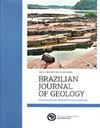The Cristalino IOCG deposit: an example of multi-stage events of hydrothermal alteration and copper mineralization
IF 0.9
4区 地球科学
Q3 GEOSCIENCES, MULTIDISCIPLINARY
引用次数: 11
Abstract
The Cristalino deposit is located 40 km east of Sossego mine, Carajás. The orebody lies along a NW-SE-striking shear zone and is mainly hosted by the Neoarchean bi-modal volcanics of the Grão Pará Group. Field work and petrographic data seconded by SEM-EDS analysis allowed recognizing an early sodic metasomatism that was followed by calcic-ferric, potassic and propylitic alterations, and finally by carbonatization. The volcanic rocks were altered under deformation regimes that changed from ductile-brittle to brittle. The deposit resulted from two mineralizing stages. The early stage took place at a greater depth and produced an ore association composed chiefly of chalcopyrite, pyrite, and magnetite as disseminations, breccia and veins particularly in Ca-Fe altered rocks. The later stage occurred at a shallower depth and formed a practically magnetite-free ore association, consisting essentially of chalcopyrite ± pyrite ± hematite in breccias and veins generated mostly during the potassic alteration. These ore associations indicate that the hydrothermal system evolved with temperature decrease and increase in fO2, Cu/Fe ratio and sulfur activity. Cristalino is conceived as a multi-stage IOCG deposit similar to others lying in the Carajás E-W corridor of IOCG systems.晶石岩储层矿床:多期热液蚀变与铜成矿的一个例子
Cristalino矿床位于Sossego矿以东40公里处,网址为Carajás。矿体沿北西-东向剪切带发育,主要赋存于新太古代格 o帕尔群双峰火山岩。野外工作和岩石学数据,再加上SEM-EDS分析,可以识别出早期的钠交代作用,随后是钙-铁、钾和丙基蚀变,最后是碳化。火山岩在由韧性-脆性向脆性转变的变形机制下发生了蚀变。该矿床形成于两个成矿阶段。早期阶段发生在较深的深度,并产生了主要由黄铜矿、黄铁矿和磁铁矿组成的矿石组合,特别是在钙铁蚀变岩中,呈散斑、角砾岩和脉状。后期发生在较浅的深度,形成了一个几乎无磁铁矿的矿石组合,主要由角砾岩中的黄铜矿±黄铁矿±赤铁矿组成,主要是钾化蚀变产生的矿脉。这些矿石组合表明,热液系统是随着温度的降低和fO2、Cu/Fe比和硫活度的增加而演化的。Cristalino被认为是一个多级IOCG矿床,类似于其他位于Carajás E-W走廊的IOCG矿床。
本文章由计算机程序翻译,如有差异,请以英文原文为准。
求助全文
约1分钟内获得全文
求助全文
来源期刊

Brazilian Journal of Geology
GEOSCIENCES, MULTIDISCIPLINARY-
CiteScore
3.20
自引率
7.10%
发文量
12
审稿时长
11 weeks
期刊介绍:
The Brazilian Journal of Geology (BJG) is a quarterly journal published by the Brazilian Geological Society with an electronic open access version that provides an in-ternacional medium for the publication of original scientific work of broad interest concerned with all aspects of the earth sciences in Brazil, South America, and Antarctica, in-cluding oceanic regions adjacent to these regions. The BJG publishes papers with a regional appeal and more than local significance in the fields of mineralogy, petrology, geochemistry, paleontology, sedimentology, stratigraphy, structural geology, tectonics, neotectonics, geophysics applied to geology, volcanology, metallogeny and mineral deposits, marine geology, glaciology, paleoclimatology, geochronology, biostratigraphy, engineering geology, hydrogeology, geological hazards and remote sensing, providing a niche for interdisciplinary work on regional geology and Earth history.
The BJG publishes articles (including review articles), rapid communications, articles with accelerated review processes, editorials, and discussions (brief, objective and concise comments on recent papers published in BJG with replies by authors).
Manuscripts must be written in English. Companion papers will not be accepted.
 求助内容:
求助内容: 应助结果提醒方式:
应助结果提醒方式:


